bulerias1981
Oud Junkie
    
Posts: 771
Registered: 4-26-2009
Location: Beacon, NY
Member Is Offline
Mood: John Vergara Luthier Lord of the Strings instrument making and repair
|
|
1927 Toufik Hanna Nahat restoration/rebuild
In early October of 2012, I received a 1927 Toufik Hanna Nahat oud from master Bassam Saba. This oud has had many problems before it made its way into
my shop: the face had been redone by a luthier two times with no success. The first time it was redone cracks appeared on the face not long after it
was finished; the luthier did the face again and not long after large cracks appeared once more. The tone was very poor when I received the
instrument: not the tone of a Nahat that we're familiar with today.
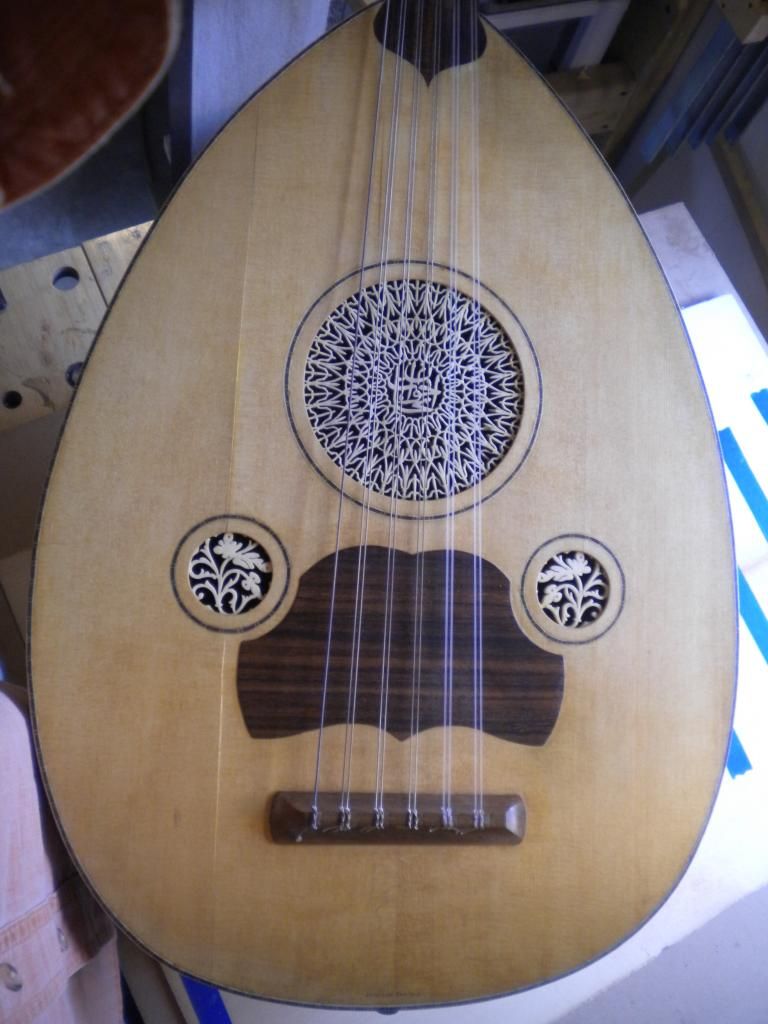
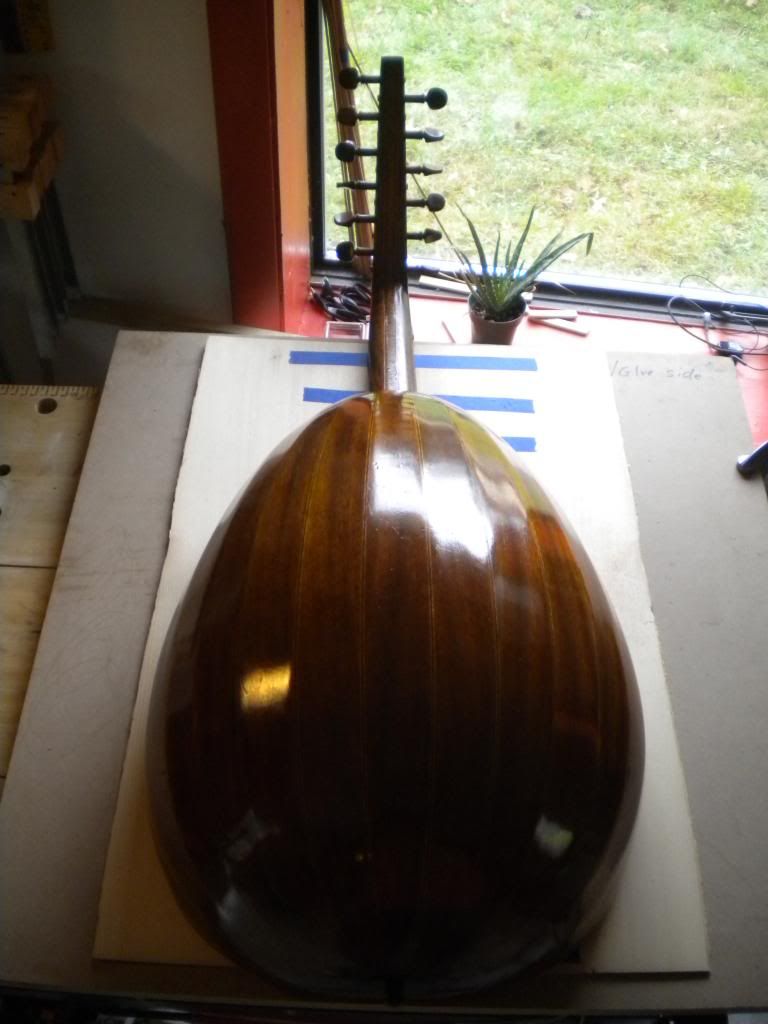
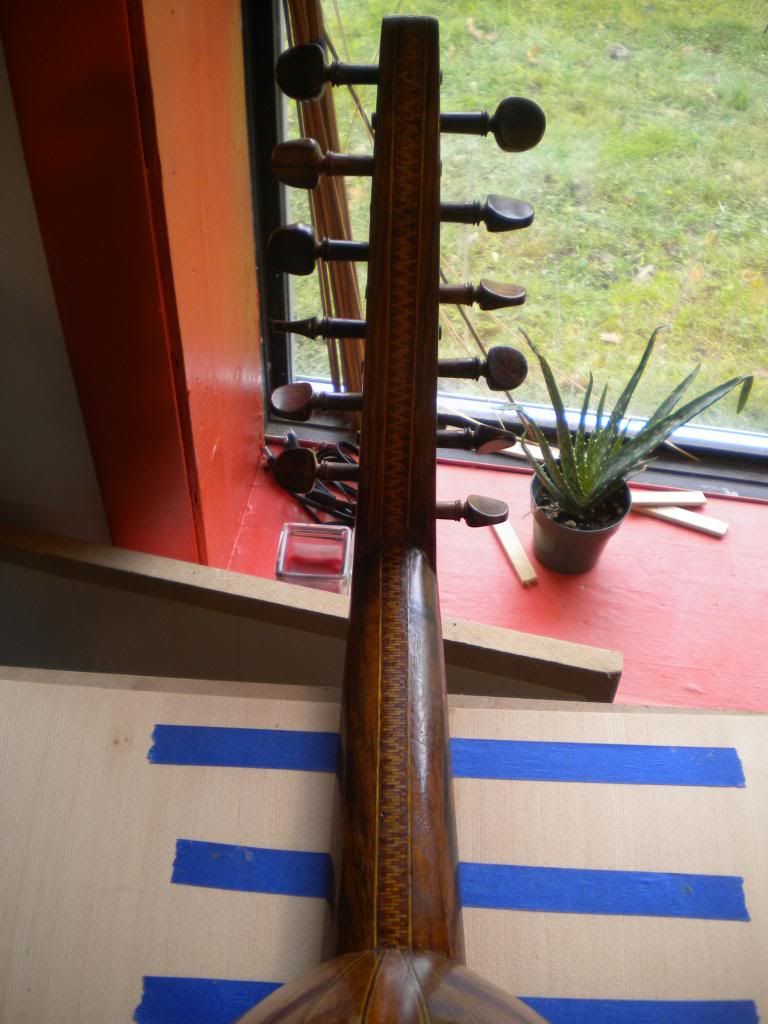
The main rosette was glued in such a way that it could not be removed without breaking it, so there was no great way for me to repair these large
cracks along the soundboard. Along with very poor tone, I made the decision to make a new top for this instrument with no fear of anything to lose at
this point.
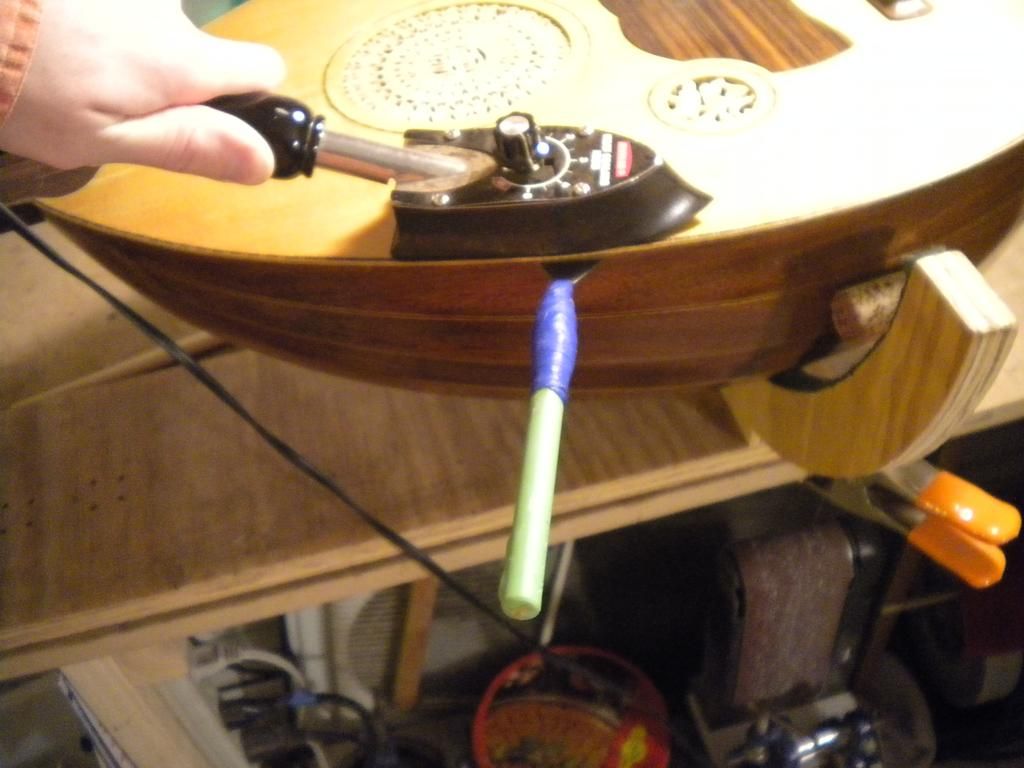
Here you can see the brace with a notch cut out where the main rosette goes. This is why it would have been impossible for me to remove the rosette!
Inside the oud I also found a twist-tie.. indictation that either the previous luthier didn't glue the small rosettes in whilst joining the top to the
bowl.
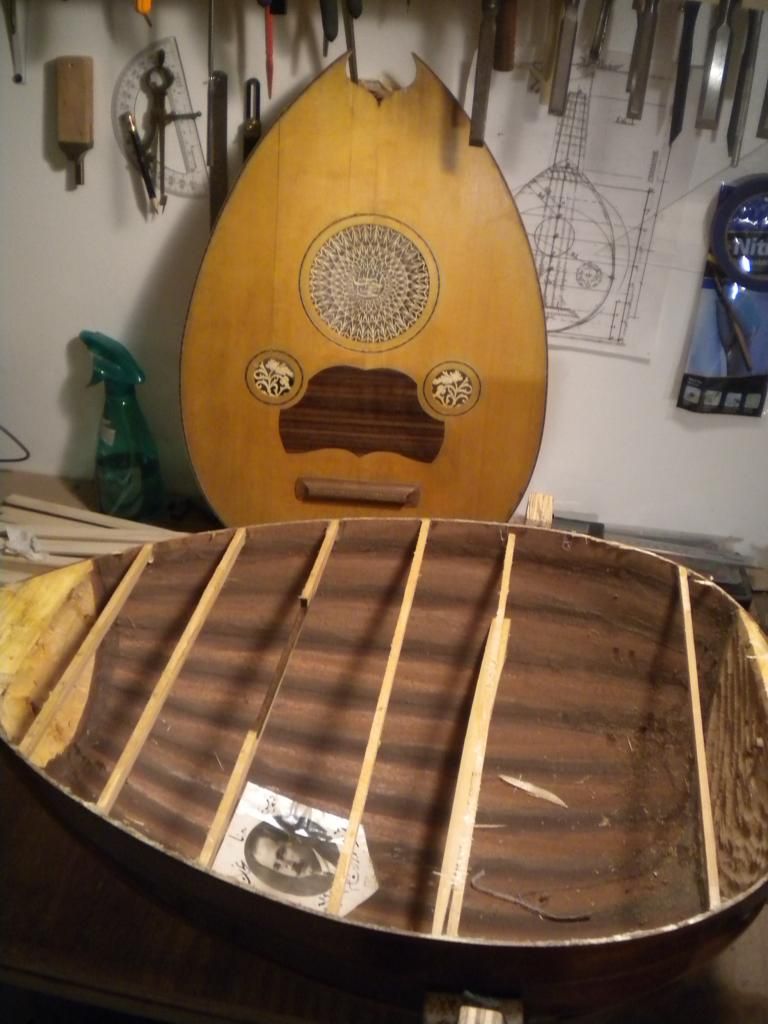
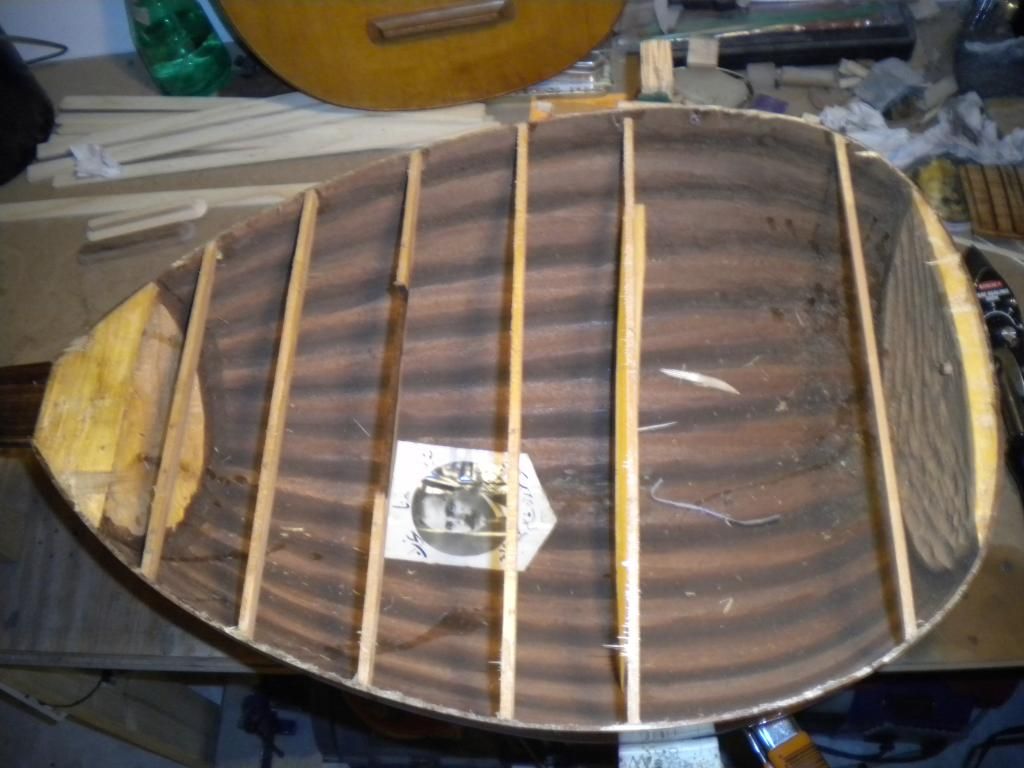

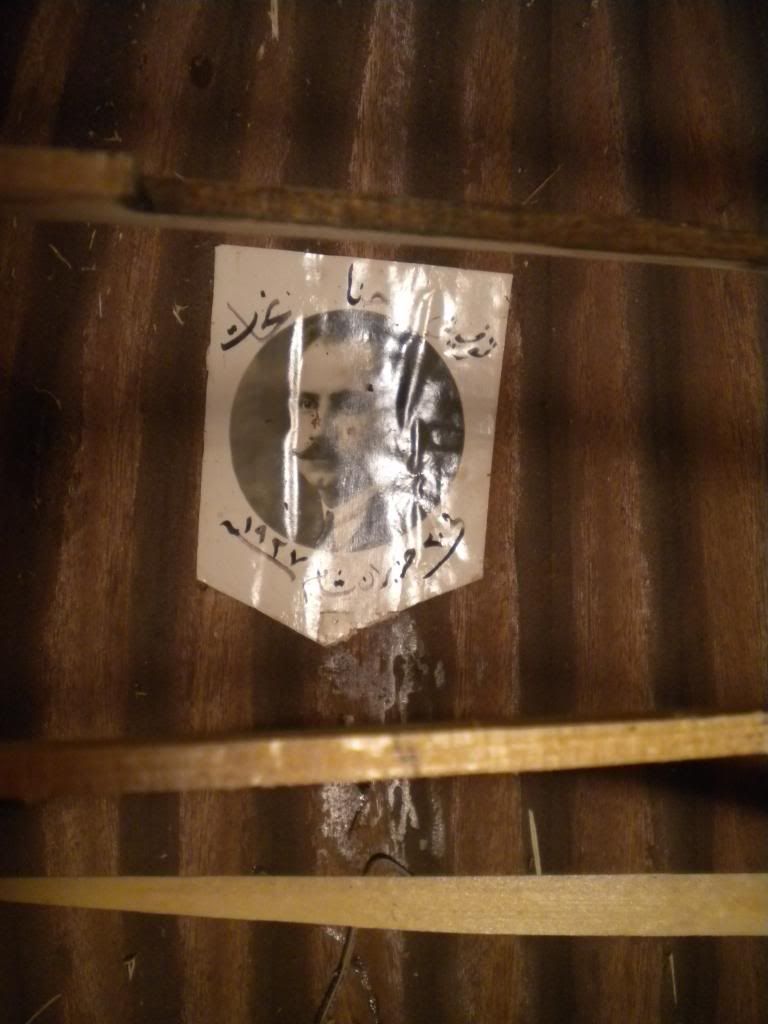
Due to the large crack on the face, one crack ran exactly though one of the small rosettes, breaking it in half. Unlike the main rosette, the two
small rosettes didn't have any wooden backing piece to protect it. These are the original rosettes from 1927. While removing the rosettes from the
previous soundboard, one of the small rosettes needed repair, and the main rosette was slightly damaged while removing. Small pieces of bone were
separated from the wooden sub-strait beneath. This was remedied by using a pair of tweezers and epoxy.

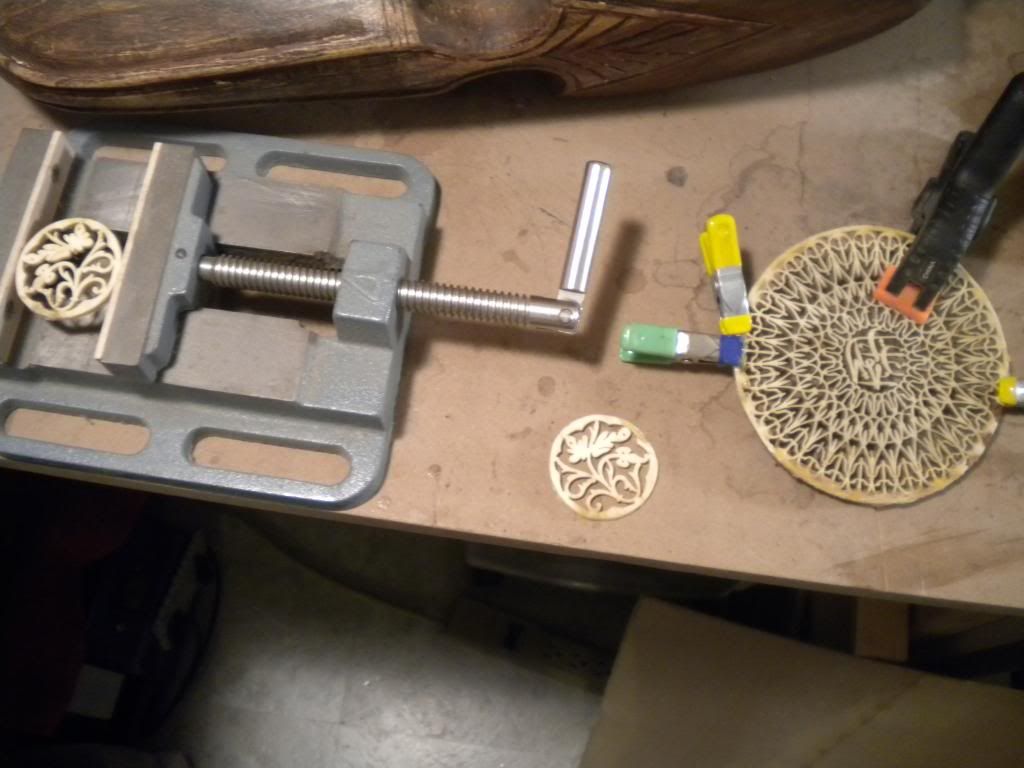
After removing the face, braces were also removed, and different braces are going to be used. I also planed the edges slightly so that the face will
be concave, previously everything was flat. Small linings were glued in the edge of the bowl so the binding will have more surface contact with the
bowl and face.
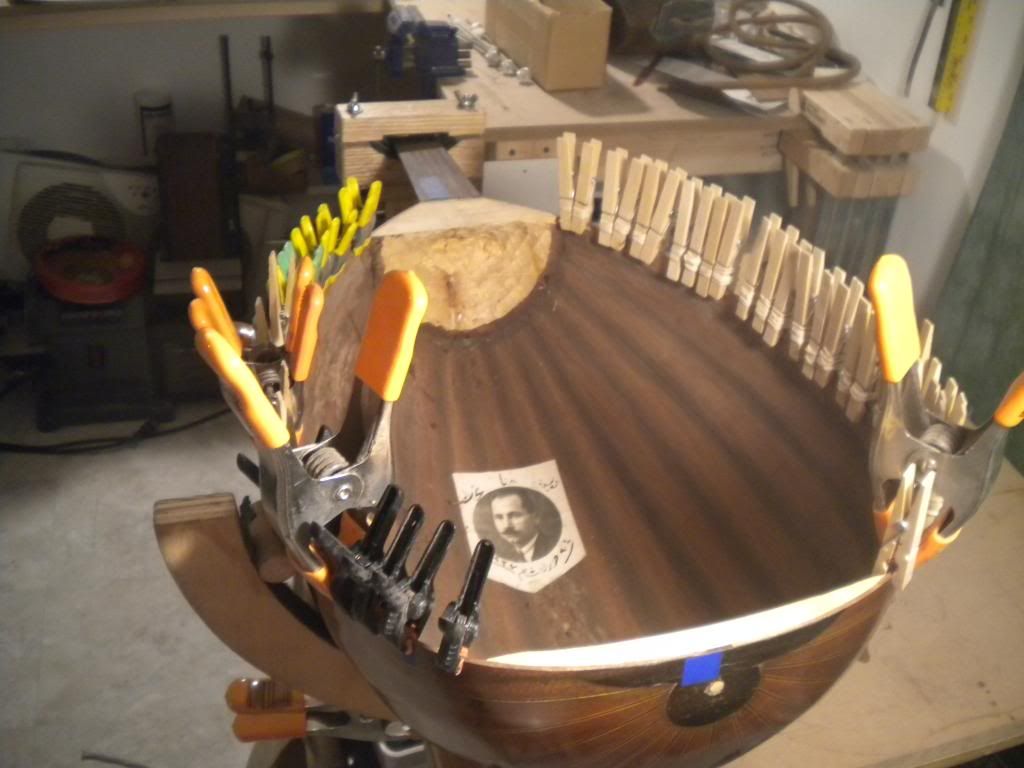
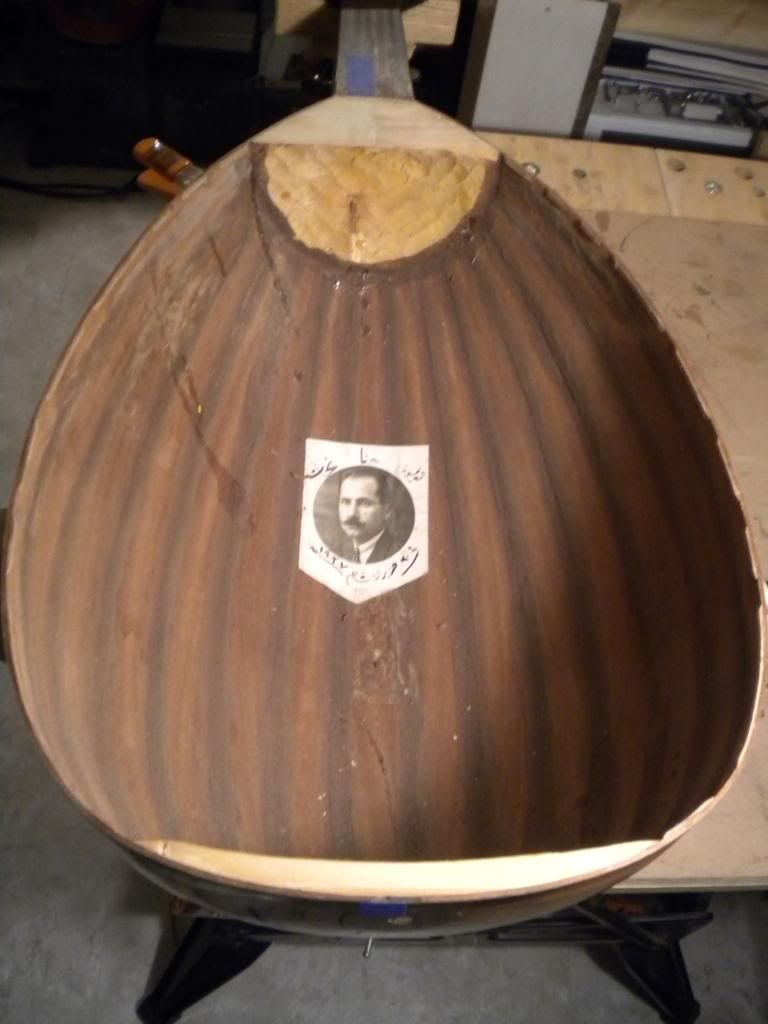
The bracing was done in collaboration with master Najib Shaheen who has a high turnout in great Arabic sound. Throwing ideas back and forth based on
the many variables of this particular instrument, we agreed on a bracing that would best suit this oud. An extended fingerboard was inlaid into the
face since Mr. Saba plays virtuosically on all the high positions. A classic Nahat style bridge will be fabricated with a bone cap as requested by Mr.
Saba.
The strings I installed initially were a used set of Kurshner with finger corrosion on them. The purpose of using old strings after putting a new
soundboard on is that there may need to be "tweaks" performed and you don't want to put a nice set on and remove and install them many times, as this
compromises the quality of the tone.
It happened to be that after the strings settled, the tension pulled the neck up and the action became too high. So I performed a neck reset, and
planed the fingerboard in some spots to make it more comfortable and to eliminate buzzing. After installing the strings post neck reset, the action
showed to be the ideal action...a combination of skill and luck based on some parameters of the oud. Lucky Mr. Saba!
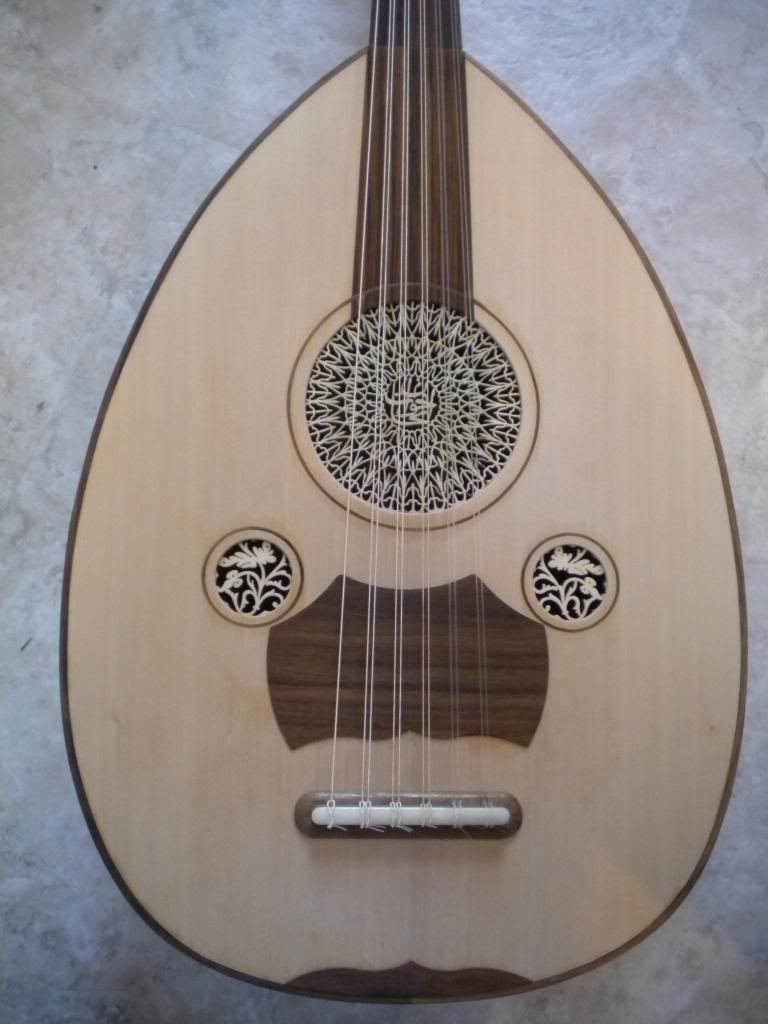
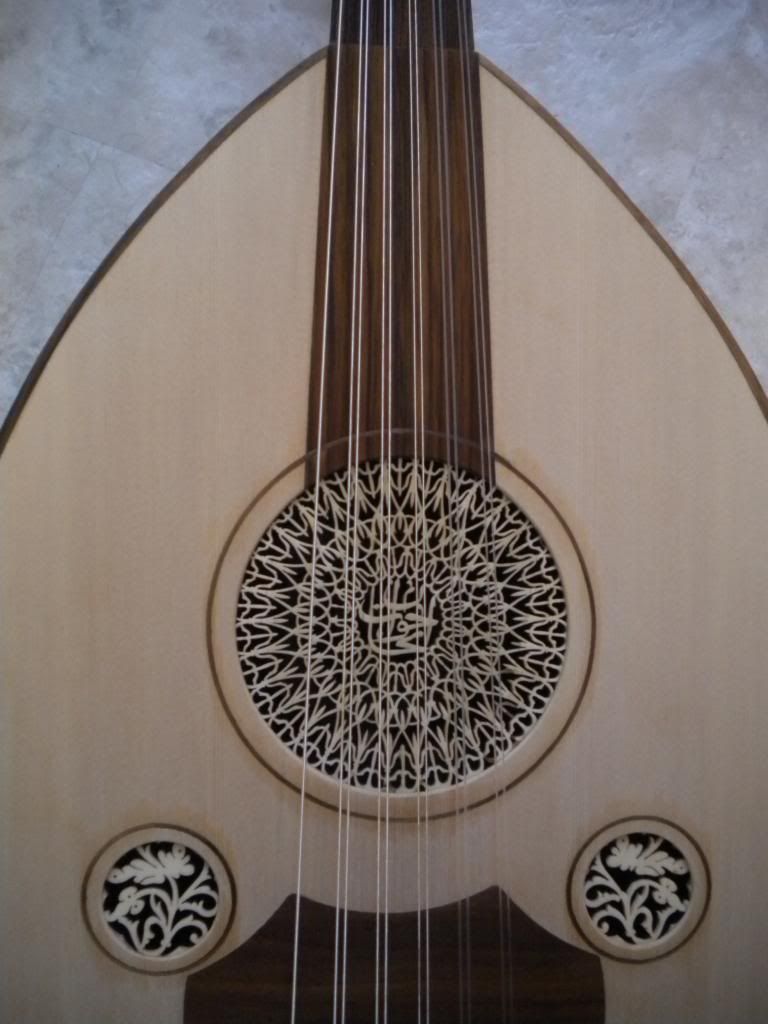
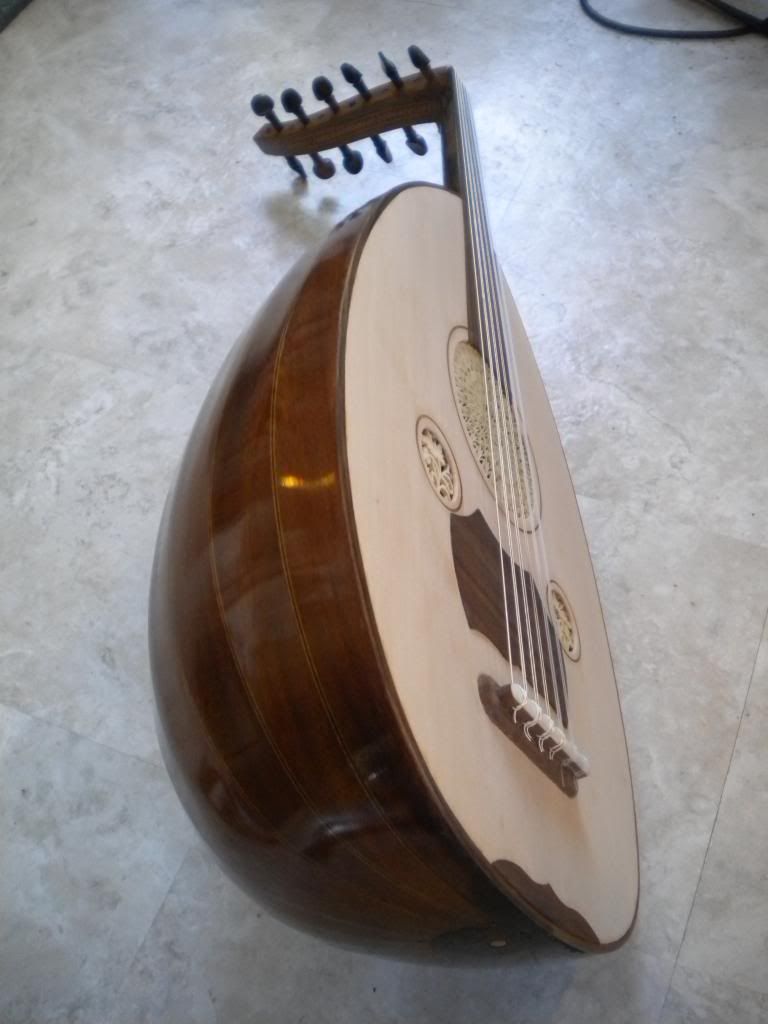
After action adjustments were made, new strings were installed. For the plain nylon, D'addario .24 and .29 were used (sol and do) and Mari for all the
wound courses.
The tone on this instrument is excellent: boomy bell tones and a sweet Arabic sound Najib Shaheen describes as the only Nahat he's heard that'd been
redone that sounds like an old Nahat!.
Hopefully I can get the owner to agree to me making a short video of him demonstrating the tone. For now here is a short excerpt of me playing the
instrument.
http://www.youtube.com/watch?v=j-C6hPPRvCA
|
|
|
SamirCanada
Moderator
     
Posts: 3405
Registered: 6-4-2004
Member Is Offline
|
|
Congradulations John.
Sounds and looks beautifull.
thanks for sharing.
@samiroud Instagram
samiroudmaker@gmail.com
|
|
|
Brian Prunka
Oud Junkie
    
Posts: 2949
Registered: 1-30-2004
Location: Brooklyn, NY
Member Is Offline
Mood: Stringish
|
|
Sounds great, John. Najib was raving to me about how great it came out, can't wait to hear it in person. Hope Bassam doesn't sit on it!
|
|
|
Alfaraby
Oud Junkie
    
Posts: 796
Registered: 9-18-2009
Location: Holy Land
Member Is Offline
Mood: Cool
|
|
Great job John. Bravo !
I wish I could see the braces and the bracing you've made. The previous weren't Nahat's at all.
Taufiq Nahat is GHN's brother, both sons of Hanna George Nahat, Abdo's younger brother. Taufiq was designated to take over after Abdo's immigration to
Brazil in 1937. He was deemed the best luthier in the family after Abdo, but didn't live long enough to accomplish his career. He died at the early
age of 49-50 of a stroke caused by high blood pressure he suffered from. Taufiq didn't make many ouds through his short career, but the ouds he made
were masterpieces, each better than the other. It's rather impossible to find a Taufiq now. Last year a lucky Parisian player flew to Cairo to grab
one of the last Taufiq's offered for sale. Poor seller ! He might have got many thousands of Euros, but lost a fortune.
Now back to John's project: I recommend Pyramid Lute strings, like the set supplied by Brian as "low tension for antique ouds". I've tried them on my
Abdo's & they sound very sound, clear, strong, warm and super responsive. Mari is a fair choice, but a Nahat deserves the best available strings,
and Pyramid Lute set sure meets this description.
Could you give us an idea about this oud's dimensions before Mr. Saba takes the oud and run ? Could you take some more clear photos of this unique
instrument: bowl, pegbox etc. (An advise is needed here: never take a photo while facing the light).
BTW Bassam Saba is an accomplished multi-talent musician who plays oud, violin, nay & flute & more.
Here's a little tasting: http://www.youtube.com/watch?v=lXgrnMoOtTk
Great salute to Njib Shaheen who had an important role in this SB restoration project. The voice was Esau's while the hands were Jacob's, or was it
vice versa !
Thanks indeed for sharing this valuable work. well done John dear!
Yours indeed
Alfaraby
alfarabymusic@gmail.com
|
|
|
FastForward
Oud Junkie
    
Posts: 225
Registered: 6-2-2008
Member Is Offline
Mood: No Mood
|
|
Nice work John. The oud sounds great as well.
I second what Alfaraby said, could you share with us some dimensions, perhaps a profile trace to complement existing information on the forum. I have
previously posted the profile and dimensions for 1921 Taufiq Nahat.
Also, any chance you can share some info on the updated bracing for the oud.
|
|
|
bulerias1981
Oud Junkie
    
Posts: 771
Registered: 4-26-2009
Location: Beacon, NY
Member Is Offline
Mood: John Vergara Luthier Lord of the Strings instrument making and repair
|
|
Thanks all..
Here are some measurements.
Scale = 605
bowl height (depth) = 195
face length = 498
face wifth = 348
nut width = 33
width @ neck joint = 52
# of ribs = 15 with spaces between
soundhole diameter = 110mm and 2x @ 38
soundboard thickness = 1.9 - 2mm
rib thickness = 2.5
The bracing was not done like traditional Nahat ouds. Some aspects were traditional others weren't. More photos to come.
|
|
|
jdowning
Oud Junkie
    
Posts: 3485
Registered: 8-2-2006
Location: Ontario, Canada
Member Is Offline
Mood: No Mood
|
|
Nice work John
From the images of the bowl it seems that the exterior is not smoothly contoured (like most ouds) but is faceted (i.e. the exterior of each rib is
more or less flat across its width) like the bowl of a lute - or is this just an optical illusion?
|
|
|
bulerias1981
Oud Junkie
    
Posts: 771
Registered: 4-26-2009
Location: Beacon, NY
Member Is Offline
Mood: John Vergara Luthier Lord of the Strings instrument making and repair
|
|
That is correct John.. each rib is flat.
|
|
|
bulerias1981
Oud Junkie
    
Posts: 771
Registered: 4-26-2009
Location: Beacon, NY
Member Is Offline
Mood: John Vergara Luthier Lord of the Strings instrument making and repair
|
|
Here is a photo of the bracing. Note.. the braces below the main soundhole are @ thicknesses of 3.7mm, the three braces above the main soundhole are @
4.5mm. The face is 1.9-2mm thick.. fairly tight grain. I also planed the edges of the bowl so that the face is concave
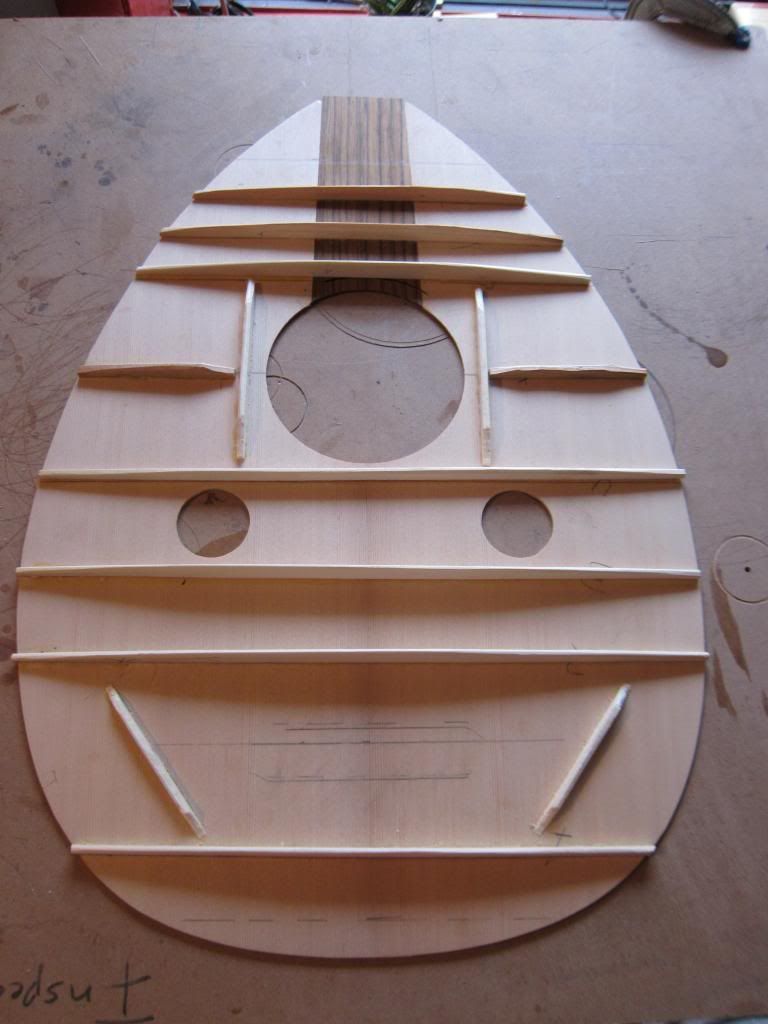
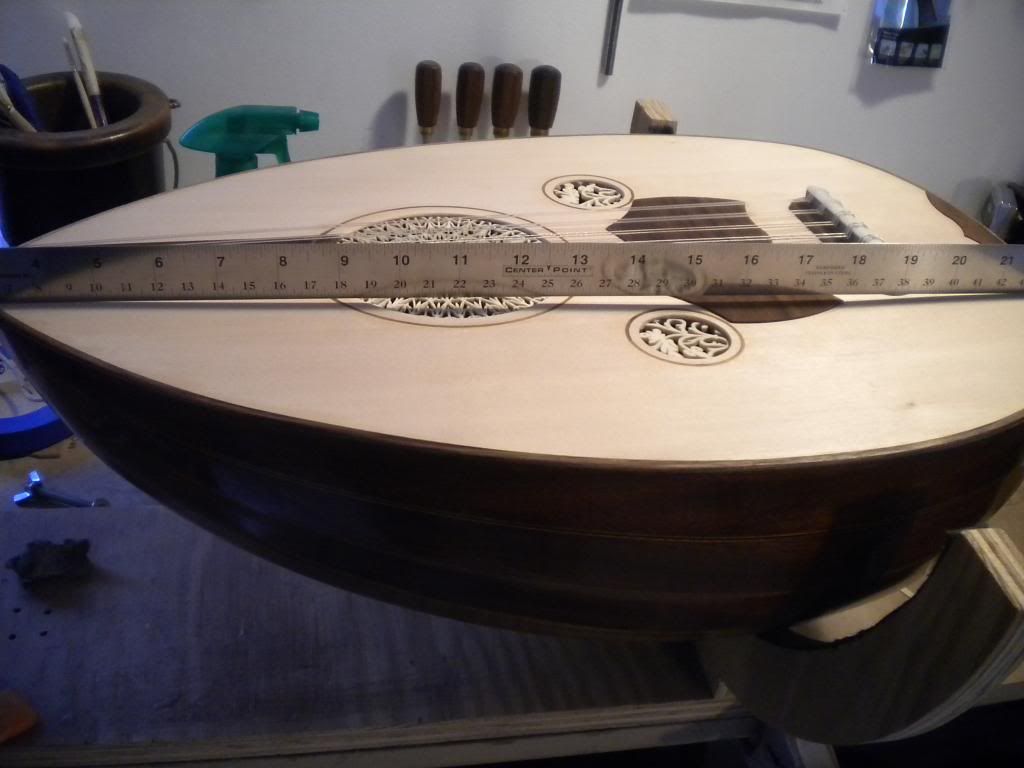
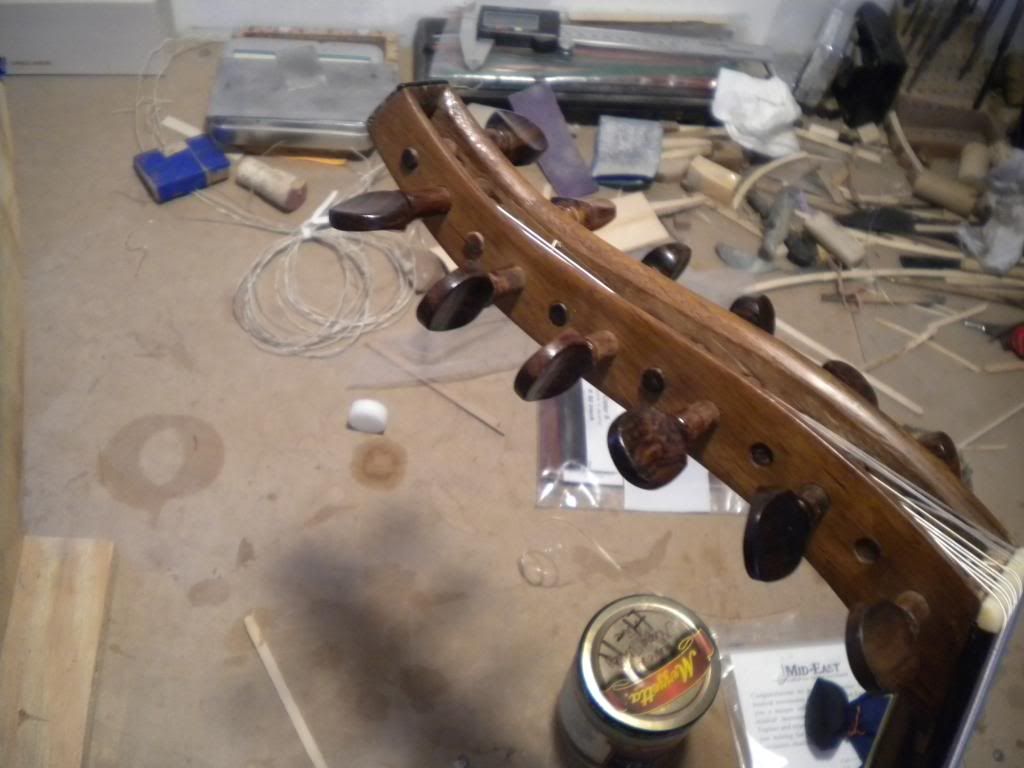
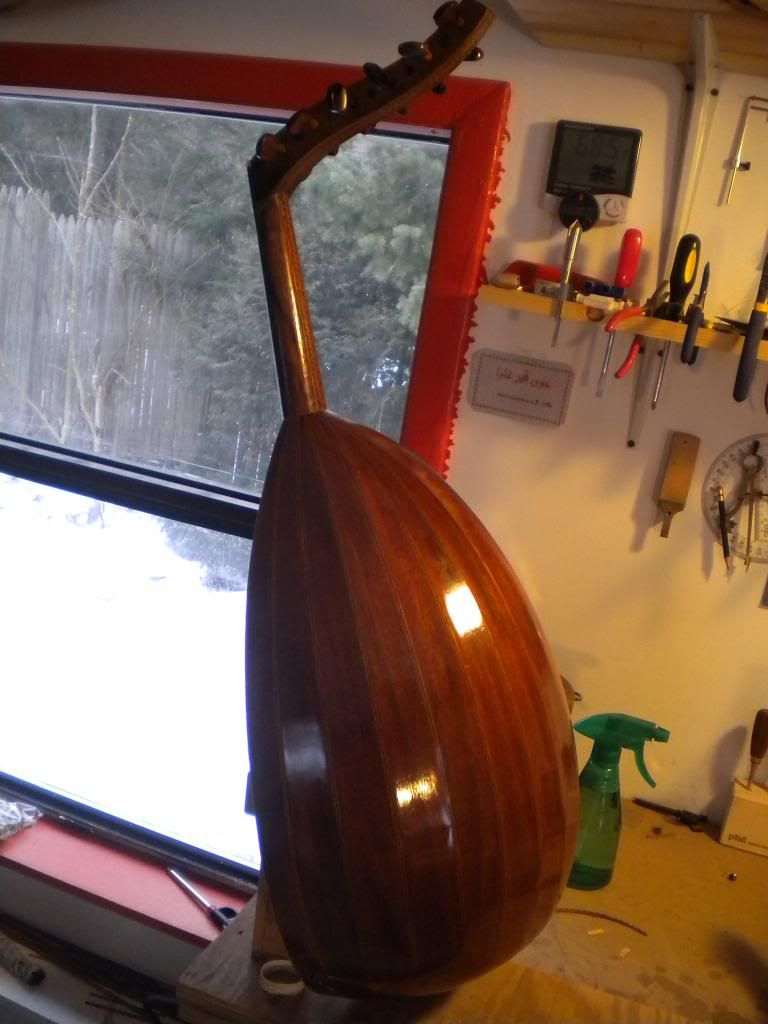
|
|
|
FastForward
Oud Junkie
    
Posts: 225
Registered: 6-2-2008
Member Is Offline
Mood: No Mood
|
|
Quote: Originally posted by bulerias1981  | Thanks all..
Here are some measurements.
Scale = 605
bowl height (depth) = 195
face length = 498
face wifth = 348
nut width = 33
width @ neck joint = 52
# of ribs = 15 with spaces between
soundhole diameter = 110mm and 2x @ 38
soundboard thickness = 1.9 - 2mm
rib thickness = 2.5
The bracing was not done like traditional Nahat ouds. Some aspects were traditional others weren't. More photos to come. |
Thanks John,
Some of the measurements seem similar, there are a few differences. In my case
Width: ~34.5cm
Body length 49cm
15 ribs ~3.8cm max width for each rib
length of curve along the middle of the back of the body from the neck to the face is 66cm
neck is 25mm in radius at the body joint
circumference is about 7.8~7.9cm
neck thickness at pegbox is 2~2.1cm
width of neck at the nut is 35mm
width of neck at the bowl is 53~54mm
the nut is curved, thickness is 3.8mm at the edges and 4.8mm at its maximum height.
Bowl is about 18.3~18.4cm deep (measured to the top of the soundboard)
The string length is 609mm
distance between the closest edge of the large rosette and the end of the string at the neck is 34.6cm
the distance from the other edge of the large rosette is 45.7.
This means that the large rosette is 111mm in diameter
the small rosette is 33mm in diameter
The inside edge to edge distance between the small rosettes is 10.7cm.
The distance from the bridge to the closest edge of the small rosette is 9.4cm.
The bridge is 10.5mm high
strings are at a height of 8mm from the soundboard at the bridge
the height of the top portion of the bridge is about 5.5~6mm
the bridge is 11.5cm wide at the base and 9.6cm wide at the top part.
|
|
|
Alfaraby
Oud Junkie
    
Posts: 796
Registered: 9-18-2009
Location: Holy Land
Member Is Offline
Mood: Cool
|
|
Hurray John, my friend ! Well done.
Some questions though: Why concave ? Why 3 braces right beyond the fingerboard ? Why the vertical braces beside the rosette ? why the diagonal short
braces towards the tail block ? Why 8 braces, while we know that the Nahats used 7 ?
I may know some answers to some of these questions, but I thought you'd better share the answers with our fellow members.
Had I have an antique oud needing to be restored/mended, I would willingly leave it in your hands buddy.
Still waiting for the photos I asked for
Yours indeed
Alfaraby
alfarabymusic@gmail.com
|
|
|
bulerias1981
Oud Junkie
    
Posts: 771
Registered: 4-26-2009
Location: Beacon, NY
Member Is Offline
Mood: John Vergara Luthier Lord of the Strings instrument making and repair
|
|
Thanks ya Jamil, your words are important to me.
A lot of good questions. I will gladly answer them all in detail.
Why concave?
I believe I've covered this topic before on the forum and others have such as Dr. Oud. However, I'll explain again.. When a face is made concave this
way, it is stronger structurally and less likely to bulge in the middle. The stress is removed from the center portion of the oud, mainly the braces
above and below the sound hole. Turkish makers do this, and I believe it to be very smart also not just structurally but also for sound production. A
flat faced oud with a fixed bridge is a oud under stress.
Why 3 braces right beyond the fingerboard?
Have you ever tried an oud and played past the neck joint and noticed there is a low quality tone? Usually its because there is no extended
fingerboard and/or two braces in that area. I believe that 3 braces helps produce a more focused, cleaner sound in that area. This oud sounds good in
the high position and this is important for someone like Mr. Saba who plays up there a lot. This is a theory backed by some trials.
Why the vertical braces beside the rosette?
They are small braces, put there for structural reasons.
Why the diagonal short braces toward the tail block?
This was Najib's idea that he does sometimes. I would have oriented these braces more classically if it wasn't for him.
I'm aware of Nahat style bracing. But I had no intention on bracing the oud in a classical Nahat way. Also Najib admits to never doing the braces the
same on any oud. I think there is truth that you have to take in all the variables and base your bracing scheme based on the situation at hand.
Neither I, or Mr. Shaheen feel that there is one way to brace an oud. Ironically the tone is very Nahat.. this is largely by accident. The goal was to
produce a good sound and to provide structural security that would be future proof. I just found out today that this is the 5th face this oud has
had!!! And I'd like it to be the last. I'm confident that it will be.
|
|
|
oudmaker
Oud Junkie
    
Posts: 220
Registered: 12-23-2004
Location: Philadelphia-USA
Member Is Offline
Mood: No Mood
|
|
The bracing system shown is exellent.
The short diagonals was suggested to me by Hadi Usta of Istanbul in 1972. I used them on all my ouds.
First I beleive that they contribute structural integrity to the location where the spacing between the two main bracings who are supporting the
brige is about 8 cm.
Secondly I think in order to produce a clean, crispeer and sustained type of sound which is the main charecter of the Turkish ouds you need to add
some mass to the area where the sound produced by a torsion movement of the bridge.
Thirdly They help to have more responds from the soundboard to the vertical movement of the bridge by carrying them towards more longitidunal
fibres.
|
|
|
Brian Prunka
Oud Junkie
    
Posts: 2949
Registered: 1-30-2004
Location: Brooklyn, NY
Member Is Offline
Mood: Stringish
|
|
I got a chance to play this oud yesterday and it sounds amazing, very old traditional Arabic sound. I'm sure it will only get better with playing and
age.
|
|
|
jdowning
Oud Junkie
    
Posts: 3485
Registered: 8-2-2006
Location: Ontario, Canada
Member Is Offline
Mood: No Mood
|
|
Interesting to compare the bracing with that of ALAMI's images of his late 19th C al Arja oud - particularly the little braces on either side of the
bridge (which slope in the opposite direction.
[file]25404[/file]
|
|
|
bulerias1981
Oud Junkie
    
Posts: 771
Registered: 4-26-2009
Location: Beacon, NY
Member Is Offline
Mood: John Vergara Luthier Lord of the Strings instrument making and repair
|
|
John, the small braces in the Al-Arja brothers oud from Lebanon are placed differently than on this Nahat soundboard. In the Al-Arja bros. oud the
small braces terminate at the bowl and point toward the soundhole. On the T.H. Nahat the braces do not terminate at the end of the bowl and they point
toward the tail block.
|
|
|
jdowning
Oud Junkie
    
Posts: 3485
Registered: 8-2-2006
Location: Ontario, Canada
Member Is Offline
Mood: No Mood
|
|
That is what I meant when I wrote 'which slope in the opposite direction'.
For general information, the attached rough sketch is the 'below bridge' bracing arrangement of an early 17th C European lute with a little brace on
the treble side - in about the same position and sloping in the same direction as on the Al-Arja oud. The curved bass bar on the lute replaces the
full, below bridge brace typically found on ouds (but never on surviving lutes)
Often there were two little treble braces as well as the bass bar on lutes.
Interesting to speculate, therefore, if the little treble braces and bass bar might have been a modification of a much earlier oud bracing layout
(prior to the 16th C) and - if so - why did the lute makers make the change? Or was this arrangement developed by the European luthiers independent of
any oud influence?
My opinion is that the German luthiers of Europe did develop this particular bracing design from the oud - via trading relationships with the Ottoman
Turks that allowed contact with their counterpart luthiers in the Middle Eastern regions of the then Ottoman Empire.
|
|
|
bulerias1981
Oud Junkie
    
Posts: 771
Registered: 4-26-2009
Location: Beacon, NY
Member Is Offline
Mood: John Vergara Luthier Lord of the Strings instrument making and repair
|
|
John,
I am familiar with this bracing scheme on European lutes. They are shown in ample quantities in Robert Lundberg's book, on pages 32, 33, 34, 36, 38,
39, and 109 for anyone who has it.
I've consider trying the curved brace on ouds at some point.
|
|
|
jdowning
Oud Junkie
    
Posts: 3485
Registered: 8-2-2006
Location: Ontario, Canada
Member Is Offline
Mood: No Mood
|
|
Yes John - it is a pretty standard arrangement among surviving lutes.
I have gone in the opposite direction and installed a single below bridge brace instead of the conventional of the treble and bass bars on one of my
lutes to good effect (the original late 16th lute by Hieber has no below bar bracing at all).
http://www.mikeouds.com/messageboard/viewthread.php?tid=7089#pid437...
I have another lute waiting completion but intend to replace the treble and bass bars (as found on the original lute) with a single 'oud like' below
bridge brace. The braced sound board has been sitting around for some years now and I notice that the assymetrical bracing pattern below the bridge
has resulted in localised distortion of the soundboard - which I do not think is a good sign.
|
|
|